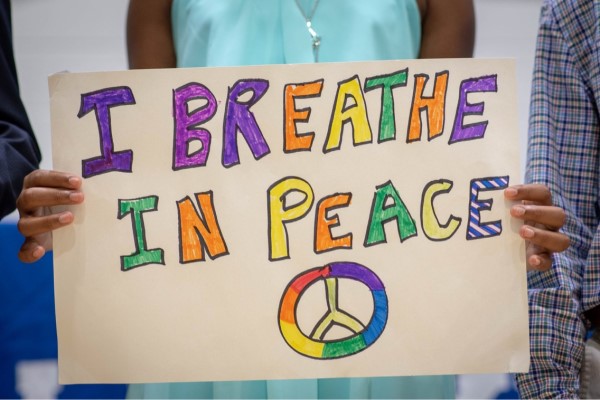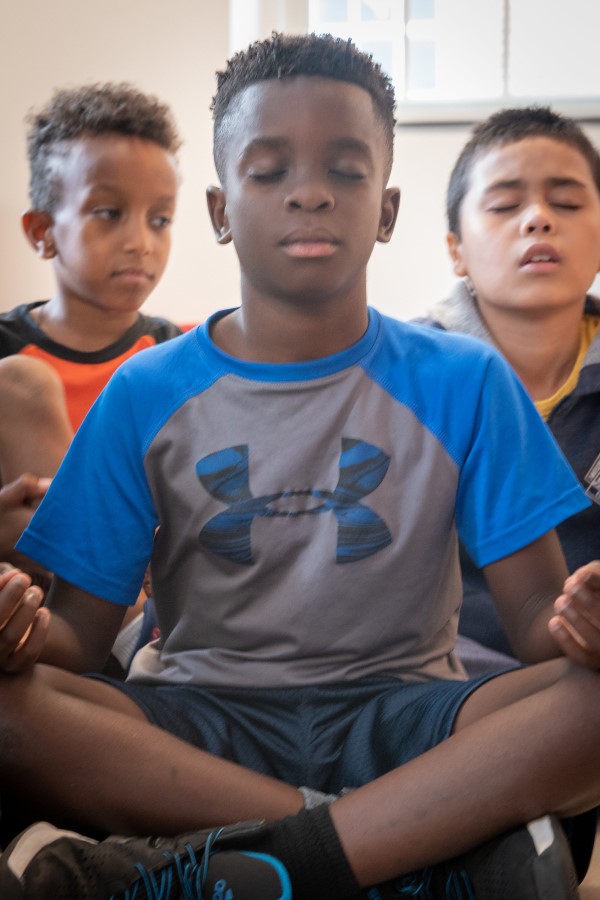Written by Linda Ryden, Founder of Peace of Mind
As the full time Peace Teacher at Washington DC’s largest public school, I get to work with all of our students in my weekly “Peace Class.” In Peace Class, kids learn about mindfulness and brain science and practice kindness, inclusion and peaceful conflict resolution. One important part of the program is Mindful Mentors. When my students get to 5th grade, they can volunteer to be a Mindful Mentor. My Mindful Mentors visit younger grade classrooms and lead Mindful Moments. Mindful Mentors is a very popular leadership program that younger students aspire to be part of and it has always been a lot of fun.

Now that we are having virtual school, I’ve been struggling to figure out how to make Mindful Mentors work. After sorting out the complicated logistics of having my 5th grade students visit other virtual classrooms, I called the first Mindful Mentors meeting. I was a little bit surprised when DeAndre showed up.
DeAndre has cerebral palsy. He uses a wheelchair and it is challenging for most of us to understand him when he talks, although he talks a lot. DeAndre has been my student for over 5 years and has always seemed to enjoy Peace Class. Now here he was with his Dad by his side helping him out and his younger sister curiously looking on. I suddenly realized that I didn’t know how to handle the logistics at all.
I made a quick decision to see if any of the kids would feel more comfortable working with a partner and a few kids raised their hands, including DeAndre. So I paired him up with a student named Kayla. If we had been in the building I would have been able to pull her aside and talk to her about how she could handle working with DeAndre given how hard it is to understand his speech. They would have had to take turns leading the mindfulness practice. But in an online classroom talking with her privately wasn’t an option. So I just had to have faith in both of them as I sent them together into a virtual 4th grade classroom.
I heard later from the teacher who hosted them that they did a beautiful job. DeAndre was able to lead a mindfulness practice from his living room with his family looking on. Because we have been creating the ritual of the Mindful Moment for many years in Peace Class, all of the children know how it starts. “Let’s get into our mindful bodies. Let’s close our eyes or look down. Let’s take three deep breaths.” So even though they might not have been able to understand DeAndre when it was his turn, they knew what he was saying and were able to follow his directions. All of the kids treated him with kindness and patience, and his partner acted with grace and generosity. This is one of so many beautiful stories that I hold on to during this very difficult time.
DeAndre’s partner is a very thoughtful child, but I think that all of the kids at our school treat DeAndre, and all of the other students with challenges, with kindness because that is part of our culture. In Peace Class we use a curriculum I developed called “Peace of Mind.” Students begin weekly Peace of Mind lessons in early childhood and carry on through Grade 5. Peace of Mind teaches children how to notice and manage emotions such as uncertainty and worry and to understand how their brains work when they feel these emotions and when they use mindfulness to calm them down. Equipped with mindfulness skills and brain knowledge, children learn and practice inclusion, kindness, patience, acceptance, and love. Most of our students do this weekly (or more often) for 7 years in the company of their classmates. These practices are all pillars of the Peace of Mind program and over time they have become an integral part of our school culture.
After 15 years of developing the Peace of Mind Program in my classroom in Washington DC’s largest public elementary school, we formed our nonprofit organization, Peace of Mind Inc., to develop, publish and share the Peace of Mind program with other educators. Peace of Mind is now used by teachers, counselors, and social workers in public, public charter and independent schools to reach over 3,500 students a year in the DC area.

As our schools prepare for an uncertain return to in-person learning, focusing on students’ social and emotional well-being has never been more important. In the year ahead, we will continue to develop transformative mindfulness and brain-science based resources, support our Peace of Mind educators personally and professionally, and facilitate and encourage the application of mindfulness and social emotional skills to the most pressing social justice issues of our time.
Though we can’t know exactly what challenges are ahead for our children, we can help to equip them with the tools to meet them with skill and compassion. We hope that the Catalogue for Philanthropy community will join us!
Interested in knowing more? We’d love to talk with you!
